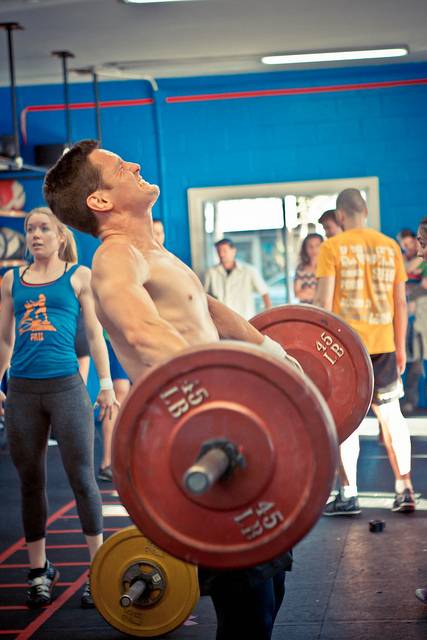Photos provided by Miguel Tapia Images and CrossFit LA.
In recent years the power clean (PC) and the similar power snatch (PS) have emerged as prime exercises in many athletes’ weight programs. Bill Starr made them a given for football players but now many other sports have gotten on the Olympic lift bandwagon, especially CrossFitters. Since both lifts involve lifting a weight high and fast, many coaches assume that they will build speed in their clients. But is this true?
Athletes who train these lifts seriously are going to be stronger because of it but the exercise is not without its critics. One of the main charges against it is that they only express speed; they don’t build it if it was never there before. Critics claim that one has to be naturally fast in the first place to do well on these lifts. It follows then that it is a waste of energy to train the PC and PS to help one’s speed. So do they build speed?
The answer is “No.” This fact surprises many but shouldn’t. Let’s look at what is really happening as these lifts are trained properly. Let’s look at a trainee who PCs 300lbs. He is much stronger than he was when he could only do 200lbs. He could pull 200 briskly then, with good technique. Now he can do 300 but, surprisingly to many, his 300s now fly up at about the same speed as his old 200 PRs did. The same holds true through the lesser intensities. Pull speed has remained the same for all intensities, faster on the lighter ones, slower as they get heavy. But he notes one interesting thing. His 85% clean (255lbs) now goes up faster than his 200 did when that was his PR. He isn’t any faster at his red-line, so why should he or any of us bother with PCs and PSs? Wouldn’t some slower (and easier) single joint exercises be better, especially since his speed has not improved at top end?
The answer again is “No.” True, pulling speed at 1RM has not improved. But what has improved is the athlete’s POWER. We do these Olympic derivative exercises for their effects on that quality, not on that of our speed. Power, as we all know is the product of force (or strength) AND speed. Power is demonstrated in high starting strength (via high muscle fiber recruitment) and/or high explosive strength (via continued firing of nerve impulses to the fibers) Genetic advantage does indeed play a part. Those more favorably blessed will do better at explosive exercises when all other factors are held ceteris paribus. Recruitment can be trained to some extent, but I suspect that the firing of the nerves is more a function of genetic endowment. It would be nice if I am wrong on this. (Readers, let me know if I am.) Train the PC properly and recruitment will increase and therefore strength. But speed will not increase appreciably.
 A related critique is that these lifts rely on momentum at their finish and therefore do not exercise the muscles in a full range of motion (ROM). That advice is great for bodybuilders but not necessarily for athletic training. Full force is not necessary on the entire ROM. Most athletic skills rely on momentum, created by stretch reflex ballistic moves. A quarterback does not put as much force onto a pass as it leaves his hand as he did when cocking it at his shoulder. It’s moving too fast at that point to do that. I’m sure you can think of other examples in sports. What the PC or PS will do is to specifically build the kind of momentum and coordination needed in explosive and fluid three joint (ankle, knee, hip) movements. But, all by themselves they will not make the athlete faster.
A related critique is that these lifts rely on momentum at their finish and therefore do not exercise the muscles in a full range of motion (ROM). That advice is great for bodybuilders but not necessarily for athletic training. Full force is not necessary on the entire ROM. Most athletic skills rely on momentum, created by stretch reflex ballistic moves. A quarterback does not put as much force onto a pass as it leaves his hand as he did when cocking it at his shoulder. It’s moving too fast at that point to do that. I’m sure you can think of other examples in sports. What the PC or PS will do is to specifically build the kind of momentum and coordination needed in explosive and fluid three joint (ankle, knee, hip) movements. But, all by themselves they will not make the athlete faster.
Finally, some criticism centres on the O-lifts not being perfectly specific to one or another athletic movement. A power clean does not have to be exactly the same as a volleyball jump, a high jump, shot put, or whatever. It is similar enough that a desired training effect can be experienced. It is also important to practice specific sporting skills. We don’t get to ignore our other training responsibilities and then blame weight training for the resultant shortcomings in our athletic skills. The Olympic lifts have proven themselves as training aids but weight training is only part of training. Starr mentioned this often. It is still true today.






